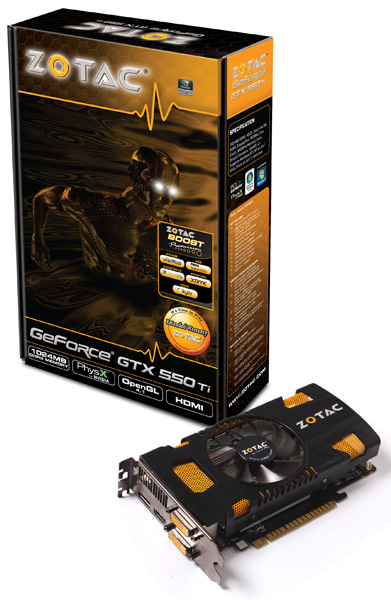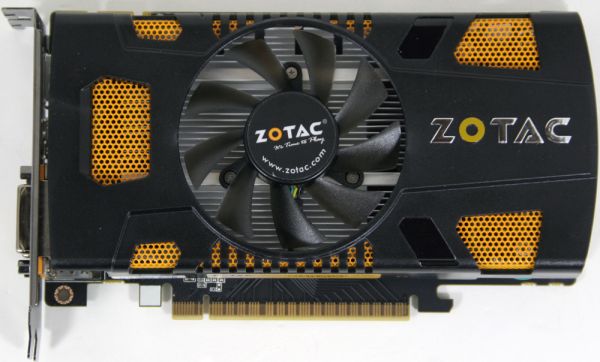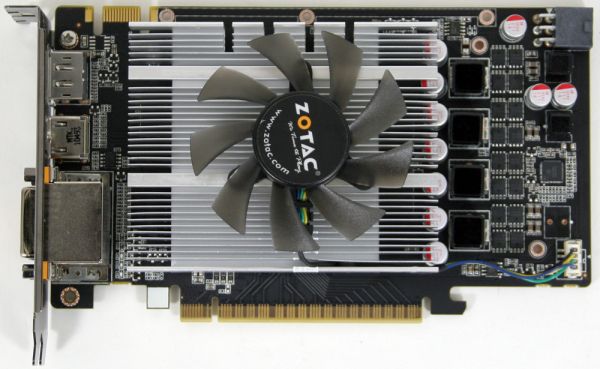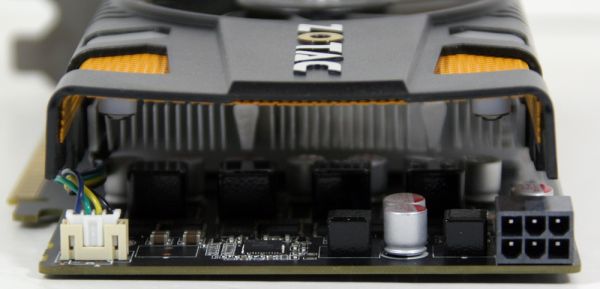NVIDIA's GeForce GTX 550 Ti: Coming Up Short At $150
by Ryan Smith on March 15, 2011 9:00 AM ESTMeet The Zotac GeForce GTX 550 Ti AMP Edition
As we stated at the start of this article, NVIDIA is not directly sampling GTX 550 Ti reference cards for this launch. Instead they have left it up to partners to do the sampling. Zotac in turn has provided us with their factory overclocked model, the GeForce GTX 550 Ti AMP, a custom design clocked at 1000MHz core and 1100MHz (4400MHz data rate) memory. We’ll be looking at performance at both stock GTX 550 and Zotac factory clocks.
The AMP is very similar in design to Zotac’s previous GTS 450 AMP card, which is not surprising given the near-perfect compatibility of the GTS 450 and GTX 550 designs. Zotac does not provide thermal/power data for their cards, but with the factory overclock we’d expect it to be a bit more than the 116W for the reference design.
At a hair under 7.5” and using a double-wide cooler design, the AMP is nearly ¾ of an inch shorter than the original GTS 450, reflecting the fact that NVIDIA’s partners often end up producing shorter cards. A simple shroud covers the card, which directs most of the airflow from the 74mm fan out the front and the rear of the card. If we remove the shroud we find a rectangular aluminum heatsink covering the GPU – the GDDR5 memory remains uncovered.
Power is supplied by a single rear-facing 6pin PCIe power socket, which provides more than enough power for a lower-power device such as the AMP. Zotac has outfitted the chip with Hynix GDDR5; 4 1Gb chips and 2 2Gb chips. All of them are rated for 5GHz operation, so even at 4.4GHz the AMP is running its memory below what the chips are capable of, not counting what the bus and GPU itself are capable of handling. Meanwhile as was the case with the GTS 450, a single SLI connector is provided for 2-way SLI.
A common theme with customized Zotac designs is support for additional display connectivity options beyond the NVIDIA reference design, and Zotac does not disappoint here. By shifting a DVI port to the 2nd slot, Zotac has outfitted the card with a full size DisplayPort, along with upgrading the HDMI port from mini to full size; they are still limited in terms of total displays by the GPU however, and even with 4 ports can only drive 2 displays at once. Zotac continues to be one of the only NVIDIA vendors we regularly see support DisplayPort, a sharp contrast from AMD & their partners who include it on virtually everything.

Rounding out the package is the usual collection of extras from Zotac. For hardware this means a molex-to-PCIe power adapter and a DVI-to-VGA adapter. Meanwhile on the software size Zotac continues to provide the Boost Premium package, which includes a collection of OEM & trial copies of various GPU-accelerated programs, including vReveal, Nero Vision, Cooliris, XBMC, and Kylo.
Zotac is pricing the card at $169 $155, $5 more than the NVIDIA MSRP for a basic card. With it comes a 2 year warranty, and a 3rd year is added upon registration.














79 Comments
View All Comments
Ryan Smith - Tuesday, March 15, 2011 - link
Our experience with desktop Linux articles in the past couple of years is that there's little interest from a readership perspective. The kind of video cards we normally review are for gaming purposes, which is lacking to say the least on Linux. We could certainly try to integrate Linux in to primary GPU reviews, but would it be worth the time and what we would have to give up in return? Probably not. But if you think otherwise I'm all ears.HangFire - Tuesday, March 15, 2011 - link
All I'm asking for is current and projected CUDA/OpenCL level support, and what OS distro's and revisions are supported.You may not realize it, but all this GPGPU stuff is really used in science, government and defense work. Developers often get the latest and greatest gaming card and when it is time for deployment, middle end cards (like this one) are purchased en masse.
Nividia and AMD have been crowing about CUDA and OpenCL, and then deliver spotty driver coverage for new and previous generation cards. If they are going to market it heavily, they should cough up the support information with each card release, we shouldn't have to call the corporate rep and harangue them each and every time.
Belard - Wednesday, March 16, 2011 - link
Someone who already has a GF450 would be a sucker to spend $150 for a "small-boost" upgraded card.When upgrading, a person should get a 50% or better video card. A phrase that never applies to a video card is "invest" since they ALL devalue to almost nothing. Todays $400~500 cards are tomorrows $150 cards and next weeks $50.
So a current GF450 owner should look at a GF570 or ATI 6900 series cards for a good noticeable bump.
mapesdhs - Wednesday, March 16, 2011 - link
Or, as I've posted before, a 2nd card for SLI/CF, assuming their mbd
and the card supports it. Whether or not this is worthwhile and the
issues which affect the outcome is what I've been researching in recent
weeks. Sorry I can't post links due to forum policy, but see my earlier
longer post for refs.
Ian.
HangFire - Friday, March 18, 2011 - link
I wasn't really suggesting such an upgrade (sidegrade). I was just saying that each generation card at a price point and naming convention (450->550) should have at least a little better performance than card it replaces.Calabros - Tuesday, March 15, 2011 - link
tell me a reason to NOT prefer 6850 over this7Enigma - Tuesday, March 15, 2011 - link
So basically this is my 4870 in a slightly lower power envelope with DX11 features. I'm shocked the performance is so low honestly. Thanks for including the older cards in the review because it's always nice to see I'm still chugging along just fine at my gaming resolution (1280X1024) 19".7Enigma - Tuesday, March 15, 2011 - link
Forgot to add, which I bought in Jan 2009 for $180 (Sapphire Toxic 512meg VaporX, so not reference design)mapesdhs - Tuesday, March 15, 2011 - link
You're the target audience for the work I've been doing, comparing cards at
that kind of resolution, old vs. new, and especially where one is playing older
games, etc. Google for, "Ian PC Benchmarks", click the 1st result, then select,
"PC Benchmarks, Advice and Information". I hope to be able to obtain a couple
of 4870s or 4890s soon, though there's already a lot of 4890 results included.
Ian.
morphologia - Tuesday, March 15, 2011 - link
Why in the name of all that's graphical would you use this Noah's Ark menagerie of cards but leave out the 4890? It doesn't make sense. If you're going to include 4000 series cards, you must include the top-of-the-line single-GPU card. It's proven to be quite competitive even now, against the lower-level new cards.